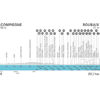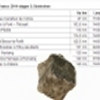Parix-Roubaix is one of the oldest and one of the most difficult one-day races with riders having to endure a daunting gauntlet of cobbled sectors before the finish in the Roubaix Velodrome. A perfect blend of positioning, power and tactical nous are required if a rider is to lift the famous cobble-stone trophy awarded to the victor, not too mention a large slice of luck. Given the conditions, mechanical issues are unavoidable in Roubaix, the timing of which can be the difference between winning and losing.
The opening 100 kilometres of racing are more of a warm up for riders with all the cobbles placed later in the route. The first stretch of pavé is near Troisvilles. The route deviates slightly from 2019’s, but from Quérénaing onward – with 120 kilometres and twenty cobbled streets to go – it is a carbon copy of the race that was won by Philippe Gilbert.
The Arenberg Forest lies at the heart of the race. Tension usually starts to rise when approaching this so called Trouée d’Arenberg, which is a 2,284 metres stretch rendered dark by the over-stretching trees on either side. The road heads straight on through the woods and because it descends slightly in the first half speeds are high and crashes lurk. If you aspire to win Paris-Roubaix, you have no choice – you have to spend energy to be at the front, otherwise, you risk getting caught up behind or in crashes.
Paris-Roubaix really is on fire when hitting the pavé to Wandignies-Hamage and the route continues onto Mons-en-Pévèle. The combination of the length of 2,985 metres and the sorry state of the cobbles account for brutal hardship in the peloton.
Still eleven sectors remaining after leaving Mons-en-Pévèle. On the trot the riders tackle the pavé of Mérignies à Avelin (700 metres), Pont-Thibault à Ennevelin (1,400 metres), Templeuve – L’Epinette (200 metres), Templeuve-Moulin-de-Vertain (500 metres), Cysoing à Bourghelles (1,300 metres), Bourghelles à Wannehain (1,100 metres) and Camphin-en-Pévèle (1,800 metres). That is seven cobbled country roads – all of which take skill, power and a heavy dose of fortune to negotiate – within 20 kilometres.
The riders hit the iconic Carrefour de l’Arbre with 16.5 kilometres left. At 2,086 metres, this stretch of pavé is feared for the sloped corners. After 1,200 metres a tricky left-hand bend leads to a slight ascent. If specialists want to strike on their beloved pavé, the Carrefour de l’Arbre is their last opportunity. At the end the riders turn right at Restaurant l’Arbre Gruson before they are treated with the heavenly feel of smooth asphalt almost all the way (15 kilometres) to the Velodrome in Roubaix.
Just two more harmless sectors, Gruson and Willems à Hem, lead the way to the last cobbled section, in Roubaix itself, which is a tribute to the race. The cobbles are neatly organised to avoid major discomfort. Riders go from here into the old Velodrome with one and a half laps to go.
Another interesting read: results Paris-Roubaix 2021.
Paris – Roubaix 2021: route, profile, more
Click on the images to zoom





